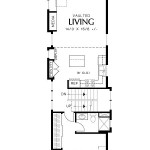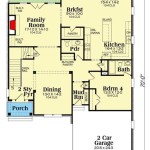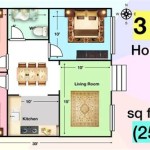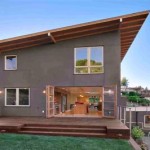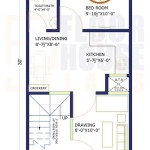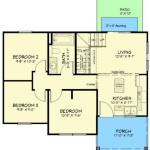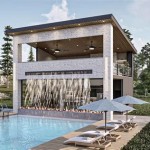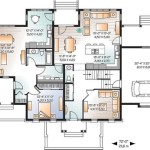One Story Small House Plans: Maximizing Space and Efficiency
One-story small house plans are becoming increasingly popular due to their versatility, affordability, and accessibility. These designs cater to a diverse range of homeowners, including first-time buyers, retirees seeking to downsize, and families looking for a cost-effective and manageable living space. The appeal lies in their ability to provide comfortable living accommodations while minimizing construction costs and optimizing land usage.
A well-designed one-story small house plan prioritizes functionality and efficient space utilization. This often involves open-concept layouts, strategic placement of windows for natural light, and thoughtful integration of indoor and outdoor living areas. These features contribute to a sense of spaciousness and create a comfortable and inviting atmosphere, despite the limited square footage.
Beyond affordability and accessibility, one-story small houses offer practical advantages in terms of maintenance and energy efficiency. With all living spaces on a single level, cleaning and home repairs are simplified. Furthermore, the reduced surface area of exterior walls compared to multi-story homes can lead to lower heating and cooling costs, contributing to long-term savings for homeowners. Carefully considering design elements and material choices is essential to achieving optimal performance in a small house plan.
Efficiency in Design and Layout
The cornerstone of successful one-story small house plans is efficient design and layout. The focus is on minimizing wasted space and maximizing the functionality of each room. Open-concept living areas, combining the kitchen, dining, and living room, are a common feature. This creates a sense of spaciousness and allows for better flow of light and air throughout the home. Multi-functional spaces, such as a combined home office and guest room, are also frequently incorporated to optimize space utilization.
Careful consideration is given to the placement of bedrooms and bathrooms to ensure privacy and convenience. Master suites are often located at one end of the house, providing a secluded retreat for homeowners. Bathrooms are strategically placed to be easily accessible from all living areas. Hallways are minimized to reduce wasted space, and storage solutions are integrated throughout the house to maximize functionality.
Built-in shelving, cabinets, and other storage solutions help to keep clutter at bay and create a more organized living environment. The strategic use of vertical space is also crucial in small house plans. Tall cabinets, high shelves, and loft spaces can provide additional storage without taking up valuable floor space. Window placement is essential in maximizing natural light. Large windows and skylights can brighten up interiors and create a more open and airy atmosphere. Strategically placed windows can also offer views of the surrounding landscape, connecting the interior with the exterior.
Consideration is also given to the orientation of the house on the lot. Maximizing southern exposure can help to warm the house in the winter, while minimizing western exposure can help to reduce overheating in the summer. Proper landscaping can also help to shade the house and reduce energy consumption. The overall goal is to create a functional and comfortable living space that maximizes efficiency and minimizes wasted space. This requires careful planning and attention to detail in every aspect of the design.
Cost-Effectiveness and Material Selection
One of the primary advantages of one-story small house plans is their cost-effectiveness. Reduced square footage translates to lower construction costs, particularly when compared to larger multi-story homes. Material selection plays a significant role in further controlling expenses. Affordable and durable materials, such as vinyl siding, composite decking, and energy-efficient windows, are frequently chosen to balance aesthetics with budget considerations.
Simplifying the design also contributes to cost savings. Avoiding complex rooflines, ornate trim, and other elaborate features can significantly reduce labor and material costs. Focus is placed on clean lines, simple shapes, and functional design elements. Prioritizing energy efficiency is another crucial aspect of cost-effectiveness. Insulating walls, ceilings, and floors properly can significantly reduce heating and cooling costs. Installing energy-efficient appliances and lighting fixtures can also contribute to long-term savings.
Exploring pre-fabricated or modular construction methods can also offer cost advantages. These methods involve building components off-site and then assembling them on the property, reducing construction time and labor costs. Careful planning and budgeting are essential to ensure that the project stays within budget. Obtaining multiple quotes from contractors and suppliers can help to identify the best prices and avoid overspending. Contingency funds are also set aside to cover unexpected expenses that may arise during construction.
The choice of interior finishes can also impact the overall cost. Choosing affordable flooring options, such as laminate or vinyl, and opting for simple and functional kitchen and bathroom fixtures can help to keep costs down. DIY projects can also be undertaken to reduce labor costs. Painting walls, installing landscaping, and building simple furniture can be done independently to save money. The key is to prioritize functionality and durability while staying within the established budget.
Accessibility and Universal Design Principles
One-story small house plans often excel in accessibility, making them ideal for individuals with mobility challenges, families with young children, and older adults seeking to age in place. The absence of stairs eliminates the risk of falls and makes it easier to navigate the home. Incorporating universal design principles further enhances accessibility and usability for people of all ages and abilities.
Wider doorways and hallways allow for easy passage of wheelchairs and walkers. Lever door handles are easier to operate than traditional doorknobs, and rocker light switches are more accessible than toggle switches. Roll-in showers with grab bars provide a safe and convenient bathing option. Adjustable-height countertops and sinks in the kitchen and bathrooms accommodate users of different heights. These features are incorporated into the design to create a more inclusive and accessible living environment.
Ramps can be used to provide access to the front door and other outdoor areas. Smooth, non-slip flooring reduces the risk of falls. Adequate lighting throughout the house ensures good visibility and reduces the risk of accidents. Lowering the threshold at doorways eliminates tripping hazards and makes it easier to move between rooms. These design considerations promote safety and independence for all residents.
Designing with future needs in mind is crucial when incorporating universal design principles. Even if accessibility is not a primary concern initially, planning for potential future needs can make the home more adaptable and livable over the long term. Building in features that can be easily modified or adapted as needs change is a cost-effective way to ensure that the house remains accessible and comfortable for years to come. Accessible design not only benefits individuals with disabilities but also enhances the overall comfort, convenience, and safety of the home for everyone.
The efficient use of outdoor space also complements the one-story small house plan. Patios, decks, and gardens can extend the living area and provide opportunities for outdoor relaxation and entertainment. Proper landscaping can enhance the curb appeal of the house and create a more inviting atmosphere. Careful planning and attention to detail are essential to create a functional, comfortable, and aesthetically pleasing living space that meets the needs and preferences of the homeowners.

48 Ideas House Plans One Story Country Front Elevation For 2024 Remodelhouseplans Small Layout Floor Tiny

Unique One Story House Plans Monster

House Plan 45185 One Story Style With 691 Sq Ft 1 Bed Bath

Stylish One Story House Plans Blog Eplans Com

Best One Story House Plans And Ranch Style Designs

One Story Economical Home With Open Floor Plan Kitchen Island Affordable Architectural House Blueprints Plans Farmhouse Small

Stylish One Story House Plans Blog Eplans Com

10 Small House Plans With Open Floor Blog Homeplans Com

Small One Story 2 Bedroom Retirement House Plans Houseplans Blog Com

Unique One Story House Plans Monster

